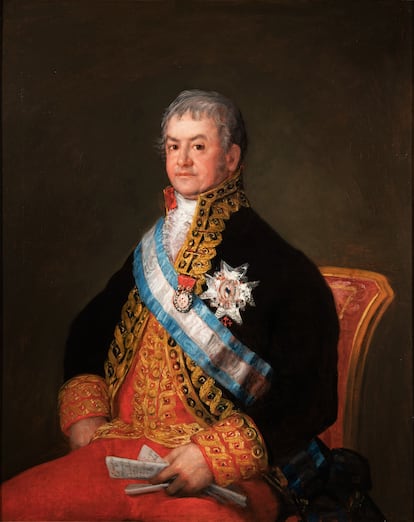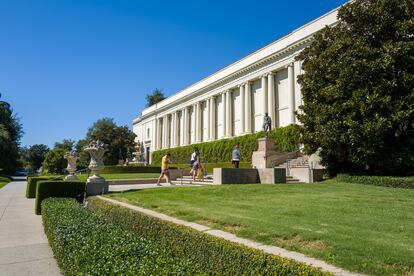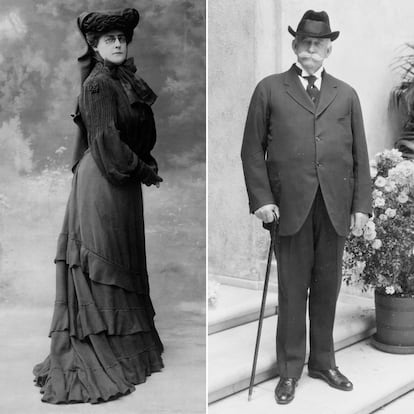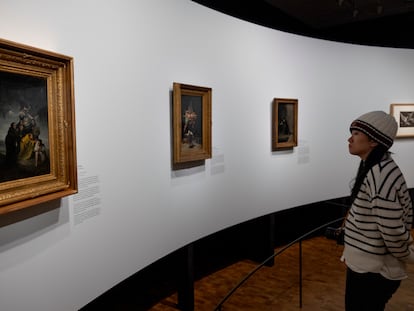Goya fever hits Southern California
The Huntington museum bought a 1807 portrait by the Spanish master and the Norton Simon Museum is showcasing over 200 of his prints


Railways were Henry Huntington’s business, but not his passion. The owner of the Pacific Electric Railway in the early 20th century ran the famous red streetcars of southern California. Known for his love of books and art, his legacy lives on in the museum that bears his name in San Marino, a picturesque town half an hour north of Los Angeles, funded by his estate and other donors. In late 2023, the Huntington acquired a remarkable painting by Spanish master Francisco de Goya: Portrait of José Antonio Caballero, Second Marqués de Caballero, Secretary of Grace and Justice (1807). It now hangs in what used to be Henry Huntington’s office.
The Huntington museum’s acquisition of the Goya portrait is now followed by the Norton Simon Museum in Pasadena — a 10-minute drive away — which announced an exhibition opening on April 19 featuring over 200 Goya prints. Southern California’s profound appreciation for Goya is evident.
The Huntington is a prominent local institution, drawing a million visitors annually. It houses a library with 12 million items, including one of the 12 remaining original Gutenberg Bibles, a 15th-century edition of Canterbury Tales, and documents penned by U.S. presidents like Washington, Jefferson and Lincoln. The art collection boasts 45,000 pieces, featuring works by Turner and Constable, surrounded by 130 acres of botanical gardens. The Huntington acquired the portrait by Goya with funding from the Ahmanson Foundation (established in the mid-20th century by an insurance company magnate). The purchase price has not been disclosed, but some sources estimated the museum bought it for a relatively low $6 million.

A plaque near the Goya portrait explains that the Huntington’s quest to own a Goya spans generations due to family history. Henry wedded Arabella Huntington, his uncle’s former wife, who had a son named Archer from a previous marriage. Archer, a fan of Spanish culture and art, played a significant role in this pursuit. “He learned to speak Spanish, traveled to Spain, and became friends with King Alfonso XIII,” said Sabina Zonno. In fact, he even bought a house in Valladolid where Miguel de Cervantes once lived. Archer loved Spain and wanted his fellow Americans to appreciate the country. He greatly respected Spain, choosing not to purchase and remove Spanish art from the country. However, he was open to acquiring it from collectors worldwide. In 1904, he established the Hispanic Society in New York. “Buying [the Goya] reconnects with those roots,” Zonno said.
“We have numerous documents from Spain, including maps and documents from the Spanish-speaking world,” Zonno said. She also says they have 80 of Goya’s Caprices prints and 10 from his Bullfighting series. In the 1940s and 1950s, the museum acquired some of his The Disasters of War etchings and three of his Follies prints, but no paintings. The museum persisted until it found this exceptional painting of José Antonio Caballero, a powerful Spanish minister known for spearheading a significant university reform and overseeing the first major global smallpox vaccination campaign. “It was the first of four Caballero portraits,” said Zonno, who said they bought it from an art dealer based in London. “There is a very similar one in Budapest, also painted in 1807. A third one in Houston was left unfinished and may have been produced by an apprentice. And there’s a miniature in Madrid’s Lázaro Galdiano Museum.” Goya also painted a portrait of Caballero’s wife, María Soledad Rocha y Fernández de la Peña. Would Zonno like to bring the portraits of the two spouses together someday? “That would be extraordinary!” she exclaimed.

Goya’s paintings in the United States might not be his most valuable work, but they continue to captivate many. According to a respected Spanish conservator, “Goya’s extensive body of work has fetched high prices for years.” The conservator, who chooses to remain anonymous due to union policy, noted the significance of Caballero’s portrait, which was created before the Napoleonic invasion. The upheaval that ensued scattered the heritage of several nations around the world. “Many pieces were later recovered,” the conservator said, “especially those that ended up in France and some that King José I escaped with. The Duke of Wellington recovered these after winning the Battle of Vittoria. But there was a lot of plundering by French soldiers, as well as by merchants seeking works by famous Spanish painters like Murillo, who were highly valued.”
“These events, and art sales before Spain’s heritage law existed, explain why there are so many pieces by Spanish artists in the museums of other countries… Once there, they acquire a life of their own, so to speak.” The laws today are stricter than they were 200 years ago. Goya’s portrait of Caballero started its journey in Spain, then went to France, and eventually made its way to Miami. The Huntington believes it was last exhibited 50 years ago in Miami.

The Norton Simon Museum in Pasadena will open its I Saw It: Francisco de Goya, Printmaker exhibition on April 19. It features over 200 works, including 80 prints from the Caprices series; 82 from The Disasters of War series; 33 from the Bullfighting series; and 22 from the Follies series. All of them belong to the museum, which also has an impressive collection of works by Zurbarán, Picasso, Degas, Van Gogh, Renoir, Monet, Cézanne, Ingres, Kandinsky, Warhol and more. Gloria Williams Sander, the curator in charge of the Goya exhibition, says they have been working on it for a year and a half.
The Norton Simon Museum, with about 160,000 annual visitors, believes this exhibition will attract a broad audience, including people familiar with Goya’s work (artists, printmakers, collectors) and history enthusiasts interested in the themes of the prints. “I feel like there’s something in the exhibition that pretty much everyone can relate to,” Sander said. Archie Huntington saw it coming 100 years ago.
Sign up for our weekly newsletter to get more English-language news coverage from EL PAÍS USA Edition
Tu suscripción se está usando en otro dispositivo
¿Quieres añadir otro usuario a tu suscripción?
Si continúas leyendo en este dispositivo, no se podrá leer en el otro.
FlechaTu suscripción se está usando en otro dispositivo y solo puedes acceder a EL PAÍS desde un dispositivo a la vez.
Si quieres compartir tu cuenta, cambia tu suscripción a la modalidad Premium, así podrás añadir otro usuario. Cada uno accederá con su propia cuenta de email, lo que os permitirá personalizar vuestra experiencia en EL PAÍS.
¿Tienes una suscripción de empresa? Accede aquí para contratar más cuentas.
En el caso de no saber quién está usando tu cuenta, te recomendamos cambiar tu contraseña aquí.
Si decides continuar compartiendo tu cuenta, este mensaje se mostrará en tu dispositivo y en el de la otra persona que está usando tu cuenta de forma indefinida, afectando a tu experiencia de lectura. Puedes consultar aquí los términos y condiciones de la suscripción digital.
More information
Archived In
Últimas noticias
Maduro pleads not guilty before the federal court in New York: ‘I am still the president of Venezuela’
A new test can detect Alzheimer’s from a finger prick
UN team enters Sudanese city of El Fasher after paramilitary massacre: ‘It’s like a ghost town’
A recipe for resistance: Indigenous peoples politicize their struggles from the kitchen
Most viewed
- Gilles Lipovetsky: ‘If you want to live better and fall in love, take Prozac, don’t look to philosophy’
- Alain Aspect, Nobel laureate in physics: ‘Einstein was so smart that he would have had to recognize quantum entanglement’
- Alvin Hellerstein, a 92-year-old judge appointed by Bill Clinton, to preside over Maduro’s trial in New York
- Maduro’s downfall puts China’s relationship with Venezuela to the test
- Why oil has been at the center of Venezuela-US conflicts for decades










































